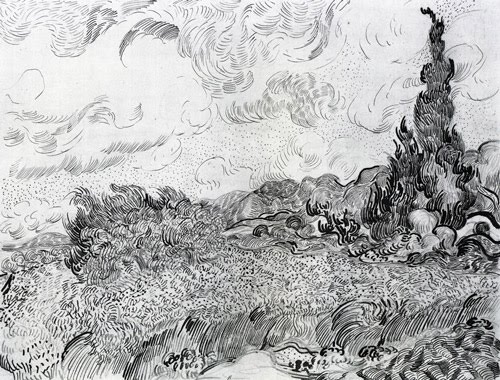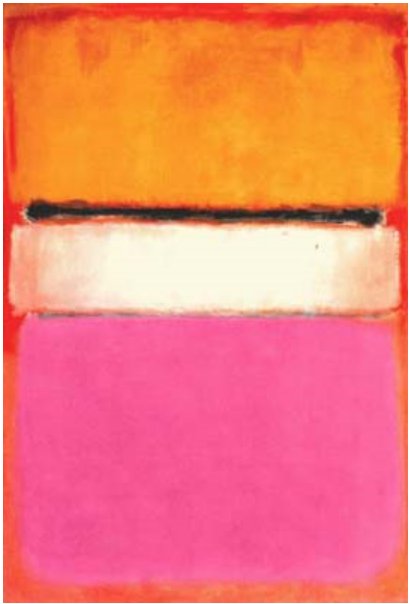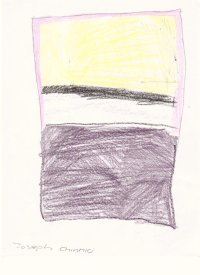Oil on Cardstock, 4 x 6 inches. Dec, 2009. Reference Image
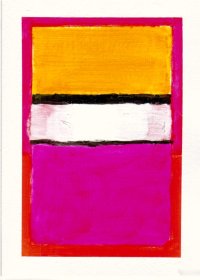
I wish you a Merry Christmas, happy holidays, and a prosperous new year.
This year I decided to try something new and different for my Christmas cards. Instead of a Hallmark card with a pre-printed image, I chose to create an original oil painting, which is what you see on the front of this card.
I started with 5 coats of acrylic gesso, then painted with high quality artist oil colors, and finished it off with a top coat of dammar varnish to preserve and protect. Please accept and enjoy my personal statement of Merry Christmas.
I began this project in September of 2009. I decided to do a tribute to the Rothko Painting “White Center”. The events that led up to that decision are:
I had come to realize that with all good art – there is a story. Earlier this year I read about a painting by Mark Rothko which sold at auction in 2007 for $70 million dollars. I was interested, so I did some Internet research and looked at some (many) of Rothko’s paintings, and I thought to myself – I don’t get it. There must be one heck of a story to make this painting – or any of his paintings worth that kind of money.
So I researched the story.
Rothko painted in a style called Abstract Expressionism (AbEx). Also called: Colorism, Color Field Painting, Action painting, Gesture painting, The New York School. The big 4 of Abstract Expressionism are:
- Mark Rothko
- Clyfford Still
- Willem de Kooning
- Jackson Pollock
The $70M painting is called “White Center” or “White Center Yellow, Pink and Lavender on Rose”.
Sheikh Hamad bin Kalifa Al-Thani and his wife (The Al-Thani ruling family of Qatar) purchased Rothko’s White Center for $72.8 million from 91-year-old philanthropist David Rockefeller.
Mr. Rockefeller owned the painting since 1960, when he bought it for $8,500 from Eliza Bliss Parkinson, the niece of Lillie P. Bliss, one of the three founders of the Metropolitan Museum of Modern Art (MoMA). Mrs. Parkinson had bought the painting from Rothko in 1960 through the artist’s dealer, Sidney Janis.
Back then, abstract paintings were not particularly Mr. Rockefeller’s cup of tea. He gravitated toward more conventional works, particularly Impressionist and Post-Impressionist paintings. But he said that Dorothy C. Miller, the first curator hired by MoMA (in 1934), urged him to acquire the Rothko, with its luminous horizontal bands of color.
Mr. Rockefeller was a vice president of Chase Bank in 1960 and had played a role in forming its art committee. While Chase was one of the first institutions to form an important corporate art collection, he said, most of his fellow bankers were too conservative even to consider something as adventurous as a Rothko.
So with Ms. Miller’s endorsement, Mr. Rockefeller scooped it up for himself, and since then it has always hung in his office, enjoying pride of place as his first Abstract Expressionist painting. At age 91 Rockefeller offered to give the painting to MoMA. They declined. So Rockefeller decided to auction off the painting, with the proceeds donated to charity. The rest is history.
About Rothko:
Rothko's work is characterized by rigorous attention to formal elements such as color, shape, balance, depth, composition, and scale; yet, he refused to consider his paintings solely in these terms. He explained: “It is a widely accepted notion among painters that it does not matter what one paints as long as it is well painted. This is the essence of academicism. There is no such thing as good painting about nothing."
Rothko: “Color is all there is, but I am not against line. I don’t use it because it would detract from the clarity of what I have to say.” Rothko defined his objective as the creation of “inner light”.
“The people who weep before my paintings are having the same religious experience I had when I painted them.” – Mark Rothko, 1965
Rothko adamantly insisted on keeping his paintings unframed, with their edges exposed.
October, 1962. Nathan Pusey, Harvard’s president paid a visit to Rothko. He looked at five canvases which he remembered as “eggplant colored”. Rothko asked what he thought, and Pusey said he found the paintings “rather sad”. Bingo, he had said the right thing. Rothko approvingly engaged him in a long conversation in which he explained the paintings as an evocation of Christ’s suffering.
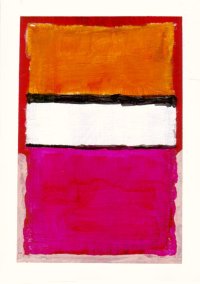
Clyfford Still made replicas (more or less identical copies) of some of his own paintings. He refers to one of his (replica) paintings owned by the Museum of Modern Art as “deliberately inferior”.
Selected comments from the pundits and/or critics:
We face an austere image. That something has been declared is beyond doubt. The glowing silence and suddenness of it all seem to dare us to blink. We blink. Pungent minor notes of lime have emerged in an erstwhile clear yellow.
Do the paintings still carry this spiritual charge? Maybe for some viewers. But Rothko's status has slipped since his suicide in 1970. The dark martyr of American art doesn't seem dark at all in White Center. And the light emanating from the stacked rectangles suggests a nice sunset, the kind you find in American landscape paintings of the Gilded Age. Our simple sensual pleasure in a luscious, candy-colored picture like White Center is always a little guilty, given the Nietzschean angst and agony that supposedly went into its making. "We are always a little embarrassed," as John Ashbery once wrote, "at esteeming his work for wrong reasons that he foresaw and continually warned against."
Herman Melville: Early in Moby-Dick, Ishmael arrives at the Spouter –Inn and sees a large picture in the gloom. Peering, he can just make out:
A long, limber, portentous, black mass of something hovering in the centre of the picture over three blue, dim, perpendicular lines floating in a nameless yeast. A boggy, soggy, squitchy picture truly, enough to drive a nervous man distracted. Yet was there a sort of indefinite, half-attained, unimaginable sublimity about it that fairly froze you to it, till you involuntarily took an oath with yourself to find out what that marvelous painting meant.
Other Pundits:
Abstract expressionism is for the lobbies of big insurance companies. (Garrison Keillor, 11/21/09)
His mature paintings could be ravishingly beautiful, in their depth and relationships of color, in their trust that Rothko’s own abandonment to feeling could evoke an equal letting-go in the viewer, in their sensitivity to the feathered and frayed edges of big shapes, and in the solemn light that they emanate. Their emotional range is wide, from foreboding and sadness (rather sad) to an exquisite and joyous luminosity.
The mind is so entirely filled with its object that it cannot entertain any other, and the work of art becomes self-sufficient.
So with all that in mind, I established my goal for the 2009 Christmas Card Project. Produce 1 copy plus 19 replicas (20 total) of the Rothko “White Center”. Two of the replicas are deliberately inferior.
The design goal(s):
- Unframed
- Soft edges (feathered & frayed)
- Evoking “rather sad”, and/or “letting go”, and/or “exquisite and joyous luminosity”
- Boggy, soggy, squitchy
- Nietzschean
- About something. Because there is no such thing as a good painting about nothing. My painting is definitely about something.
- Eggplant, with pungent minor notes of lime (sounds like something you might find on the menu at an expensive French restaurant)
I encourage you to do a Google search on:
Rothko “White Center”
This will lead you to many Internet images of the Rothko painting. Pick one, and compare it to your Christmas Card. Are you weeping? Are you rather sad? Are you like me and thinking, I don’t get it?
If for any reason you just don’t like the card, perhaps you can pass it along to a big insurance company with a lobby. It is my sincere hope that this card will in some small way contribute to your enjoyment of this holiday season.
Merry Christmas.
